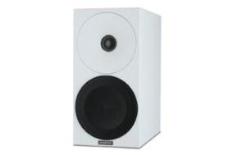What Hi-Fi? Verdict
The Helium 510s are great in parts, but lack the all-round game to worry the class leaders
Pros
- +
A bold, well-projected presentation
- +
good build
Cons
- -
Lacks coherence
- -
low frequencies sound a touch too soft
Why you can trust What Hi-Fi?
One thing these Amphions don't lack is enthusiasm. They've got a hard-charging attitude that helps them sound bold and punchy.
As you'd imagine, this kind of presentation works a treat on music such as Massive Attack's Heligoland where the Helium 510's speed and agility work well. There's a decent amount of detail as well as the ability to pound out high-level transients with ease.
These speakers are relatively compact (31cm tall), so properly deep bass is off the menu, but that 13cm paper coned mid/bass driver doesn't want for trying.
One of Amphion's trademarks is a low crossover point: 1.6kHz. That's well below the 2.5-3.5kHz that most speakers operate at. This takes the crossover point out of the region where most people are most sensitive to it.
Uneven presentation
It'll come as no surprise that the Heliums are well integrated, in the tonal sense at least. Where they're less successful is in matching the character of the mid and treble to that of the bass.
Midrange upwards, these speakers sound incredibly taut and solid. They project sound strongly, in a way that makes most rivals seem a little reserved.
The bass, on the other hand, sounds a little soft and fluffy in comparison, and this leads to a rather uneven presentation.
Flat dynamics disappoint
Other weaknesses include an inability to deliver varied dynamics of the kind that keeps music interesting, be it a Schubert symphony or Kanye West's Love Lockdown. You can add restricted refinement and hazy timing to the negatives.
The Helium 510s counter these flaws with decent build quality and the ability to play loudly with conviction, but that isn't enough to save this Finnish speaker from an average rating.
It just hasn't got the weaponry to worry rivals such as ATCs SCM 11s or Roksan Kandy K2 speakers.
Follow whathifi.com on Twitter
What Hi-Fi?, founded in 1976, is the world's leading independent guide to buying and owning hi-fi and home entertainment products. Our comprehensive tests help you buy the very best for your money, with our advice sections giving you step-by-step information on how to get even more from your music and movies. Everything is tested by our dedicated team of in-house reviewers in our custom-built test rooms in London, Reading and Bath. Our coveted five-star rating and Awards are recognised all over the world as the ultimate seal of approval, so you can buy with absolute confidence.


